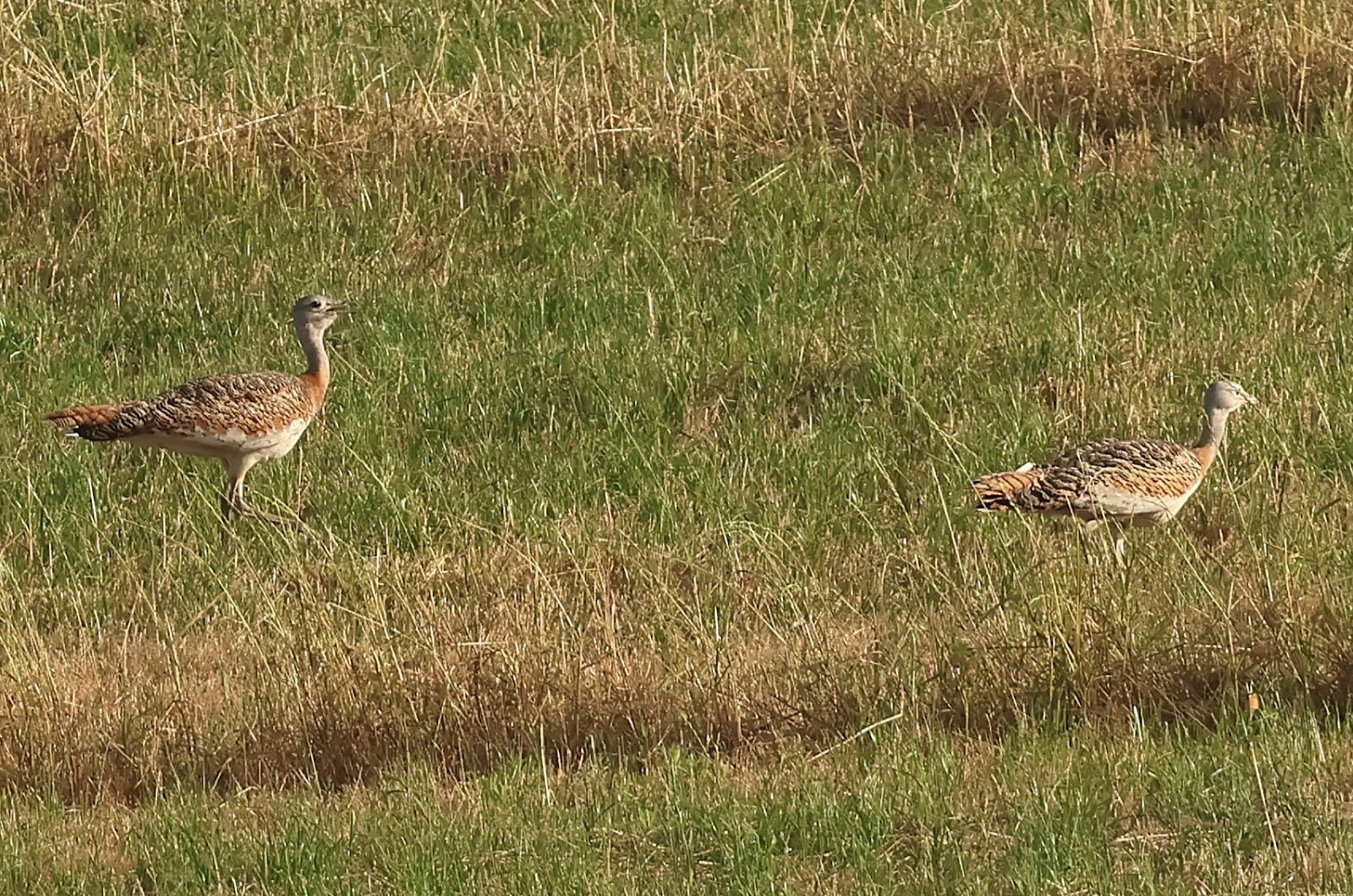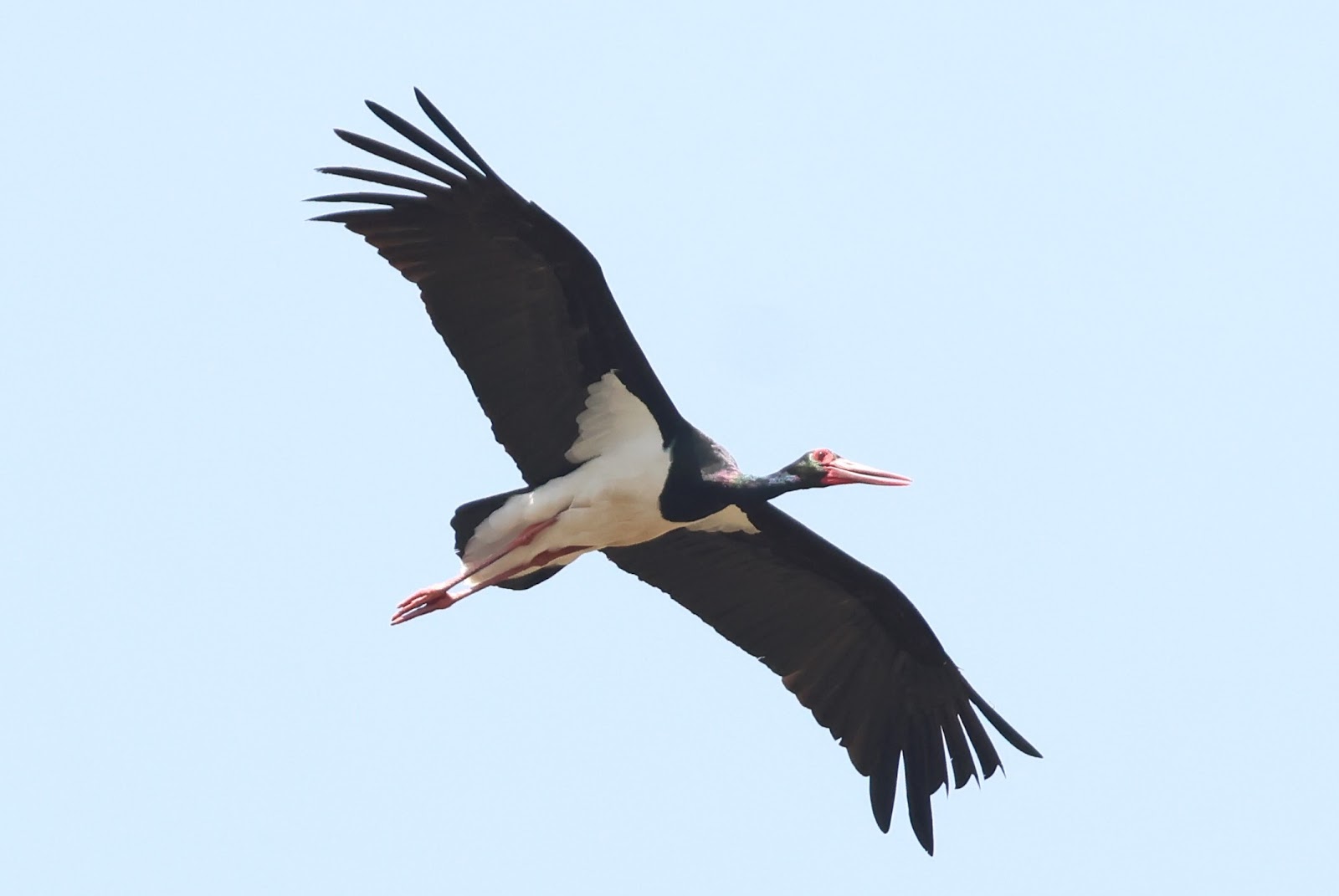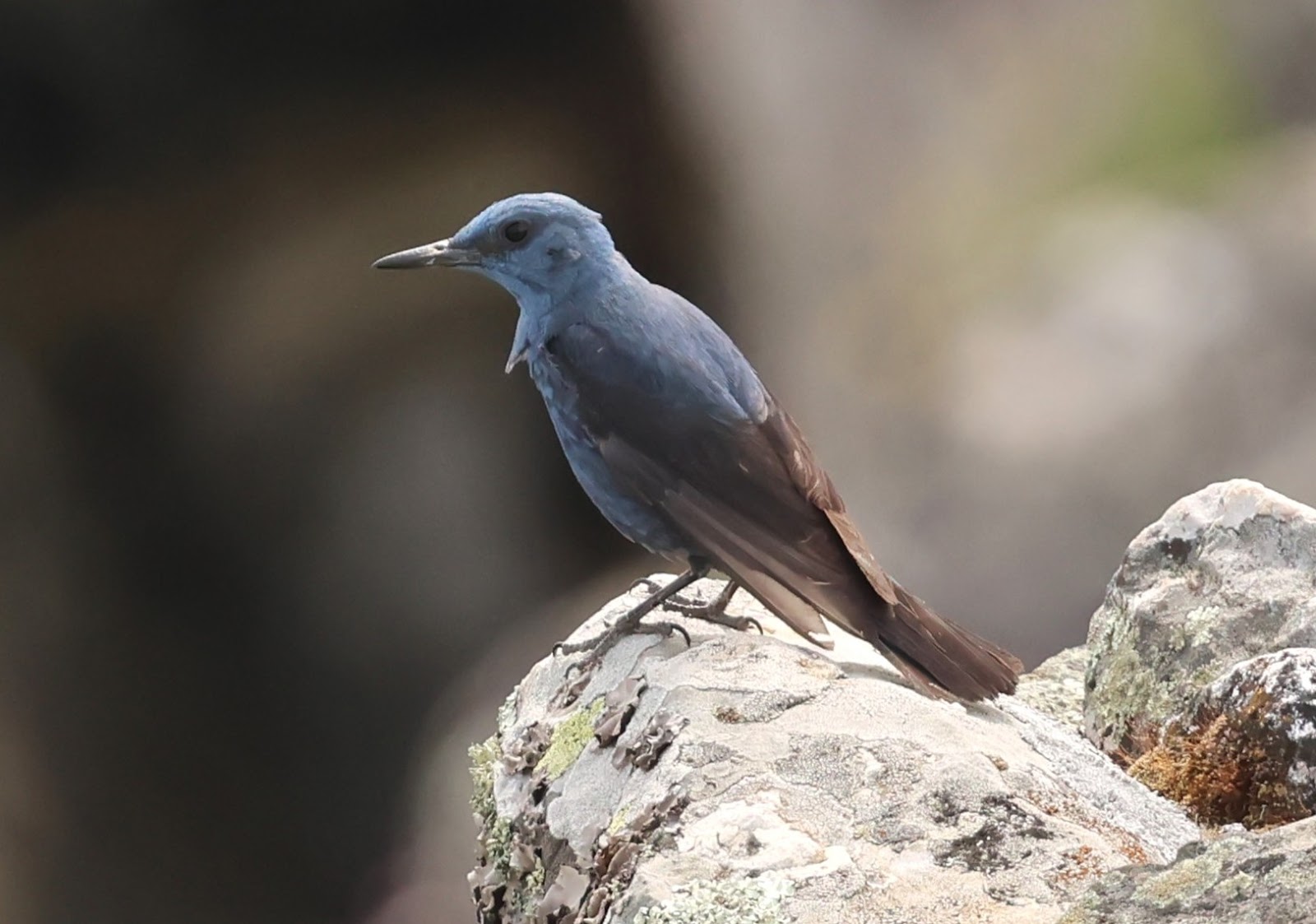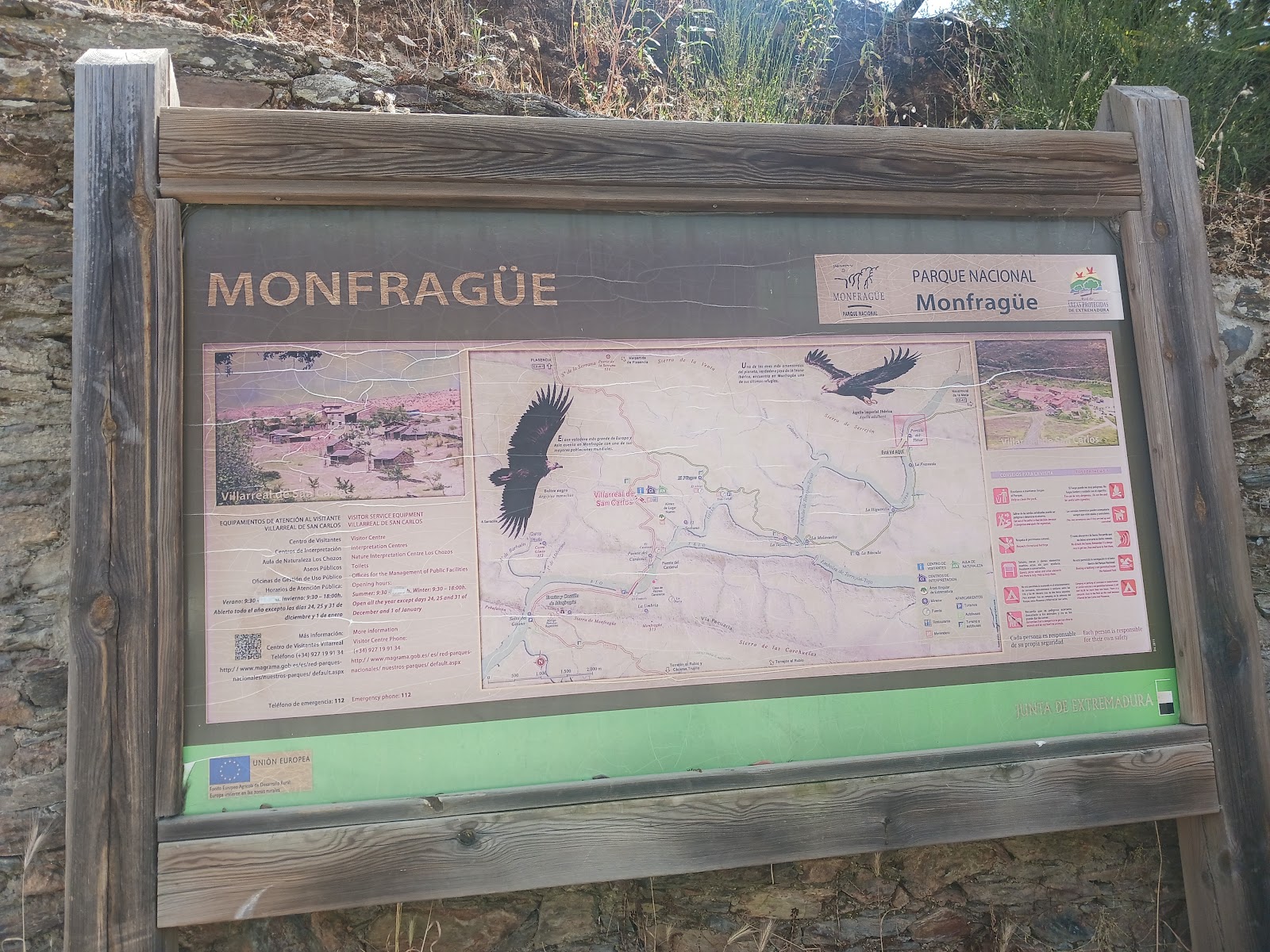We arrived in the town of Calera y Chozas on the evening of May 30. For the next couple of days, we would mostly be revisiting locations I had covered a few days earlier. A trip out to the fields in the evening struck gold with three subadult males relatively close to the road.

Subadult male Great Bustards (photo by Paul Thompson)
We spent about another 20 minutes scouring the area and stopped by a location for a Bee-eater flock I had found on my previous visit. This gave a great photo opportunity for this colorful species. Since there were not any other must-see birds from Paul’s perspective, we decided to try Arrocampo Reservoir the next morning, a well-known wetland area roughly en route to Monfrague.

European Bee-eater (photo by Paul Thompson)
The previous evening, we had run over a strand of barbed wire on the dirt track through the fields. There was no immediate apparent damage to the tires, but we were keeping an eye on the situation. As we got close to Arrocampo, the tire pressure warning lit up. Since it was clearly a slow leak, we continued on to the site and got birding.
We started off at Observatorio 1. There is a Purple Heron colony in the reedmace here and we enjoyed good looks at multiple birds, along with a Western Swamphen and a Little Bittern. Another highlight was a close fly-by a Ferruginous Duck. A Savi’s Warbler was singing out in the reedmace and we were soon able to locate the bird singing from the top of a stem. While watching the warbler, I heard a Penduline Tit calling and we soon had fabulous looks of a male perching along the fence line.

Penduline Tit (by Paul Thompson)
One easy species Paul still needed was Great Reed Warbler. This was supposed to be ‘guaranteed’ at Arrocampo, but it seemed that densities were lower as the vegetation was reedmace rather than reeds. Going around to Observatorio 2, we eventually got reasonable looks at a bird. We then finished off with exceptional views of a cracking male Sardinian Warbler.

Sardinian Warbler (by Paul Thompson)
Since the tire was by now visibly quite low, we backtracked to the nearest town. It was a Saturday and we needed to get the fix done there and then since nothing would be open on Sunday. We had already verified that the vehicle had no spare, just a tire repair kit, which I really didn’t want to have to use. After finding a couple of closed tire shops that should have been open, we arrived at one that was open. Although I was hoping it was a simple flat repair, the garage told us that we needed a new tire, which seems to be always the case these days in the US too! They only had a ‘second-hand’ tire but this was clearly in a much better state than the ones we had on the car. Since they were only asking 30 euros for the tire and associated labor, we ended up replacing both front tires and were soon back on the road.
We arrived into Monfrague around mid-day at the Portilla del Tietar. While scanning the soaring vultures, I noticed a immature large eagle that was clearly a juvenile Spanish Imperial Eagle. A short while later, I heard the call of a Spanish Imperial Eagle and we found an adult bird chasing off the juvenile bird. The size difference indicated the adult was a male and the juvenile a female. Although the birds were moderately distant, we could see features like the white leading edge to the inner forewing quite well. We were delighted to pick up the eagles so quickly and then spent the next hour or so working the shaded woodlands along the roadside to see species like Turtle Dove, Nightingale, Short-toed Treecreeper and Subalpine Warbler, while experiencing more Golden Oriole frustration.
We made a few more stops elsewhere in Monfrague on the way to our hotel, picking up Black Stork, Hawfinch and a few other species

Black Stork (photo by Paul Thompson)
After hanging out in the hotel and having a late lunch, we headed out to the Portilla del Tietar to try to get better looks at the eagles along with Eagle Owl, as well as searching for a few passerines Paul needed to see.
An initial eagle watching session failed to gather repeat views of the Spanish Imperial Eagles but we were rewarded with a pair of Bonelli’s Eagles cruising by. As sunset approached and with Paul still needing to see Iberian (formerly Azure-winged) Magpie, I suggested some American-style birding by driving the car slowly along the road with the windows open, making occasional stops. This worked quite well as we soon had great looks at Iberian Magpies picking up food from the road.

Spanish Sparrow (by Paul Thompson)
We also snagged close-by Spanish Sparrows and Woodchat Shrikes. Arriving at a stream with nice riparian vegetation, we finally ended the Golden Oriole hoodoo with pretty good looks at a male mostly out in the open. The biggest surprise was the plethora of Nightingales that emerged on to the roadside along sections of the road that had heavy brush. We counted at least 14 birds along a KM or two of road, as well as hearing a few more singing. As we approached back to the Portilla, I heard a singing Rock Sparrow, but we were only able to obtain brief, so-so views. A long vigil for the Eagle Owl, accompanied by a couple of other birders, proved fruitless again.
The next morning, we targeted a ‘Swift Big Day’ as four species occur regularly in Monfrague, three of which Paul was yet to see on the trip. We started off at a bridge over the lake where I had seen a couple of Alpine Swifts a few days earlier.

Alpine Swifts (by Paul Thompson)
I suspected that the swifts were likely breeding on the bridge alongside a huge House Martin colony. I was also hoping that there might be other hirundines and swifts feeding low over the lake in the cool of the morning. This didn’t prove to be case at all, but we did have fantastic looks at at least six Alpine Swifts and a minimum of 250 House Martins. A check of a nearby drinking area turned up a juvenile Firecrest in addition to the usual tits and finches.
We then headed up to the castillon to look for more swifts and any raptors that got up as thermals developed. We climbed up to the top of the castillon, where we had an excellent 360 degree view of the surrounding area. Paul had been frustrated in attempts to photograph Blue Rock Thrush, but a nice male popped up on a nearby structure in good light.

Blue Rock Thrush (by Paul Thompson)
Swifts began to come and go in small numbers. First up was a good look at a Pallid Swift. We then had multiple looks at three Common Swifts. Eventually a couple of White-rumped Swifts appeared and we eventually had as many as six in view at once, along with a brief looks at two Pallid Swifts. All the swifts gave excellent looks, but getting photographs as they shot by at high speed proved too much of a challenge. In addition to the swifts, House and Crag Martins and Red-rumped Swallows were all feeding up around the Castillon.

Eurasian Griffon (by Paul Thompson)
Other than eye-level views of Griffons flying by and a pale morph Booted Eagle, the raptor show was pretty unexceptional and we headed back down, scoring a nice Orphean Warbler near the car park.

Western Orphean Warbler (by Paul Thompson)

Comments
Post a Comment